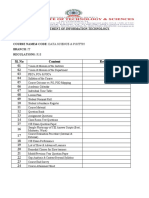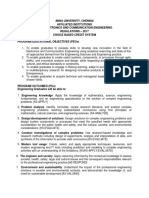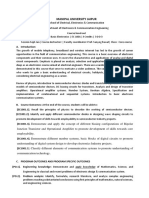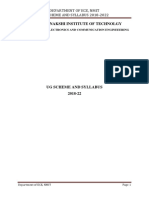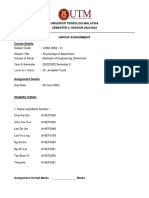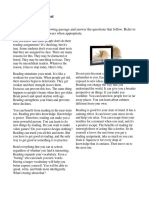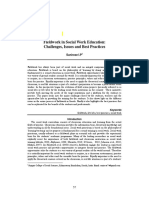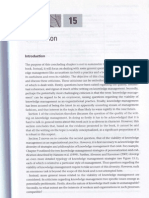DEPARTMENT OF ELECTRONICS AND COMMUNICATION ENGINEERING
CEC349 - RFID SYSTEM DESIGN AND TESTING
QUESTION BANK
R-2021
Prepared by Page 1
K. KOKULAVANI, AP/ECE
J.J. College of Engineering and Technology, Trichy.
�DEPARTMENT OF ELECTRONICS AND COMMUNICATION ENGINEERING
III YEAR / VI SEMESTER
REGULATION 2021
CEC349 - RFID SYSTEM DESIGN AND TESTING
Faculty In Charge Head of the Department
Mrs. K. Kokulavani M.E Dr. S. Sumithra M.E., Ph.D
Assistant Professor Professor & Dean
Department of ECE Department of ECE
Prepared by Page 2
K. KOKULAVANI, AP/ECE
J.J. College of Engineering and Technology, Trichy.
� INSTITUTE VISION & MISSION
VISION:
To become a globally recognized “Centre of Academic Excellence” providing Quality
Education to all students.
MISSION:
To provide Quality Education in the fields of Engineering, Management, Information,
Technology and other Engineering areas.
DEPARTMENT VISION & MISSION
VISION:
To impart latest knowledge and skills so as to kindle innovation and creativity among
students.
MISSION:
To develop and sustain a culture of research while promoting values, ethics
M1
and professionalism.
To develop competent technocrats who strives continuously in pursuit of professional
M2
excellence in the field of Electronics and Communication Engineering.
M3 To offer well-balanced curriculum to acquire professional competencies.
To develop the state of the art infrastructure and research for effective teaching
M4
learning process.
To strengthen the soft skills especially for rural students through co-curricular and
M5
extracurricular activities.
Prepared by Page 3
K. KOKULAVANI, AP/ECE
J.J. College of Engineering and Technology, Trichy.
� PROGRAM EDUCATIONAL OBJECTIVES (PEOs)
To provide the students with a strong foundation in the required sciences in order to
PEO1
pursue studies in Electronics and Communication Engineering.
To gain adequate knowledge to become good professional in electronic and
PEO2
communication engineering associated industries, higher education and research.
To develop attitude in lifelong learning, applying and adapting new ideas and technologies
PEO3
as their field evolves.
To prepare students to critically analyze existing literature in an area of specialization and
PEO4 ethically develop innovative and research oriented methodologies to solve the problems
identified.
To inculcate in the students a professional and ethical attitude and an ability to visualize
PEO5
the engineering issues in a broader social context.
PROGRAM OUTCOMES (POs):
Engineering knowledge: Apply the knowledge of mathematics, science, engineering
PO1 fundamentals and an engineering specialization to the solution of complex engineering
problems.
Problem analysis: Identify, formulate, review research literature, and analyze complex
PO2 engineering problems reaching substantiated conclusions using first principles of
mathematics, natural sciences, and engineering sciences.
Design/development of Solutions: Design solutions for complex engineering problems and
design system components or processes that meet the specified needs with appropriate
PO3
consideration for public health and safety, and the cultural, societal, and environmental
considerations.
Conduct investigations of Complex Problems: Use research-based knowledge and research
PO4 methods including the design of experiments, Analysis and interpretation of data, and
synthesis of the information to provide valid conclusions.
Modern tool Usage: Create, select, and apply appropriate techniques, resources, and
PO5 modern engineering and IT tools including prediction and modeling to complex
Engineering activities with an understanding of the limitations.
The engineer and society: Apply to reason in formed by the contextual Knowledge
PO6 to assess societal, health, safety, legal and cultural issues and the consequent responsibilities
relevant to the professional engineering practice.
Environment and Sustainability: Understand the impact of the professional engineering
PO7 solutions in societal and environmental contexts, and demonstrate the knowledge of, and
need for sustainable development.
Prepared by Page 4
K. KOKULAVANI, AP/ECE
J.J. College of Engineering and Technology, Trichy.
� Ethics: Apply ethical principles and commit to professional ethics and Responsibilities and
PO8
norms of the engineering practice.
Individual and team work: Function effectively as an individual, and as a member or leader
PO9
in Diverse teams, and in multidisciplinary settings.
Communication: Communicate effectively on complex engineering activities with the
engineering community and with society at large, such as, being able to comprehend and
PO10
write effective reports and design documentation, make effective presentations, and give and
receive clear instructions.
Project management and finance: Demonstrate knowledge and understanding of the
PO11 engineering and management principles and apply these to one’s own work, as a member
and leader in a team, to manage projects and in multidisciplinary environments.
Life-long learning: Recognize the need for and have the preparation and ability to Engage
PO12
in in dependent and life-long learning in the broadest context of technological change.
PROGRAM SPECIFIC OUTCOMES (PSOs):
Design, develop and analyze electronic systems through application of relevant
PSO1
electronics, mathematics and engineering principles.
Design, develop and analyze communication systems through application of
PSO2 fundamentals from communication principles, signal processing, and RF System
Design & Electromagnetics.
Adapt to emerging electronics and communication technologies and develop
PSO3
innovative solutions for existing and newer problems.
Prepared by Page 5
K. KOKULAVANI, AP/ECE
J.J. College of Engineering and Technology, Trichy.
� CEC349 RFID SYSTEM DESIGN AND TESTING L T P C
2 0 0 2
COURSE OBJECTIVE:
To discuss the fundamentals of near field and far field RFID communications
To articulate the standards and protocols used in RFID systems
To describe the operating principles of RFID tag and reader
To introduce the security aspects and system architecture of RFID systems
To illustrate the industrial and scientific applications of RFID systems
UNIT I INTRODUCTION 6
RFID Principles: Near-field based RFID – Properties of Magnetic field – Far-field based RFID –
Properties of Backscatter RF Systems – Modulation techniques – Frequency based property
comparison of RFID Systems
UNIT II RFID STANDARDS AND PROTOCOLS 6
RFID Industry standards: EPC global – ISO15693 Vicinity cards and RFID – ISO14443 Proximity
cards and RFID – The NFC forum – Reading collocated RFID tags: Query Tree protocol – Query
Slot protocol
UNIT III OPERATING PRINCIPLES 6
RFID Tag components: RFID tag types – the 1-Bit Transponder and Chipless Tags – RFID readers
and middleware component – Communication fundamentals: Coupling, Data encoding, multi-path
effect – Tag, Reader and sensor communication.
UNIT IV DATA INTEGRITY AND SECURITY 6
The checksum procedure – Multiaccess procedures – Attacks on RFID Systems – Protection by
Cryptographic measures
UNIT V RFID ENABLED SENSORS AND APPLICATIONS 6
RFID enabled Sensors: Antenna design challenges – IC design – Integration of sensors and RFID –
Power consumption and Link budget. 127
TOTAL: 30 PERIODS
Prepared by
K. KOKULAVANI, AP/ECE Page 6
J.J. College of Engineering and Technology, Trichy.
� COURSE OUTCOMES
On completion of this course, the students expected to be able to:
CO1 Classify RFID systems based on frequency, architecture and performance
CO2 Define standards for RFID technology
CO3 Illustrate the operation of various components of RFID systems
CO4 Describe the privacy and security issues in RFID Systems
CO5 Discuss the construction and applications of RFID enabled sensor
CO’s-PO’s & PSO’s MAPPING
PO’s PSO’s
CO’s
1 2 3 4 5 6 7 8 9 10 11 12 1 2 3
1 3 3 3 2 2 3 1 - - 1 - 3 2 3 2
2 3 2 3 2 2 2 1 - - 1 - 3 3 2 2
3 3 3 3 2 3 2 1 - - 1 - 3 2 3 2
4 3 3 3 2 2 2 1 - - 1 - 2 3 2 2
5 3 3 2 2 2 2 2 - - 1 - 3 2 2 2
AVG 3 3 3 2 3 3 1 - - 1 - 2 3 3 2
1 - Low, 2 - Medium, 3 - High, ‘-' - No correlation
TEXT BOOKS:
1. Roy Want, RFID Explained, Springer 2022.
2. Amin Rida, Li Yang, Manos M. Tentzeris, RFID Enabled Sensor Design and Applications, Artech
House, 2010
REFERENCE BOOKS:
1. Klaus Finkenzeller, RFID Handbook, 3rd Edition, Wiley, 2010
2. Syed Ahson, Mohammad Ilyas, RFID Handbook, CRC Press, 2008
3. Paris Kitsos, Security in RFID and Sensor Networks, CRC Press, 2016.
Prepared by
K. KOKULAVANI, AP/ECE Page 7
J.J. College of Engineering and Technology, Trichy.
� UNIT– I
INTRODUCTION
PART–A
Q. CO
Questions BT Level Complexity
No Mapping
1 What are all the principles of RFID tag? CO1 Understand Medium
What specific problem do we think we can solve with
2 CO1 Understand Medium
RFID?
How are RFID tags different from Barcode labels? CO1 Understand Medium
3
4 What is RFID? CO1 Understand Medium
What are the major components and cost for
5 CO1 Understand Medium
implementing a successful?
What are the properties of magnetic field in far field
6 CO1 Understand Medium
RFID system?
Define modulation techniques. CO1 Remember Low
7
8 List the uses of RFID tags. CO1 Remember Low
9 Define Backscattering. CO1 Remember Low
10 List the uses of RFID tags. CO1 Remember Low
Prepared by
K. KOKULAVANI, AP/ECE Page 8
J.J. College of Engineering and Technology, Trichy.
� PART–B
CO
Q. No Questions BT Level Complexity
Mapping
a) Explain the supply chain of EPC.
1 CO1 Understand Medium
b) Describe the effect of environment on RFID system.
Discuss about the RFID system with help of block
2 CO1 Understand Medium
diagram.
3 Elaborate in detail about Near Field RFID. CO1 Understand Medium
4 Describe in detail about Backscatter in RFID systems. CO1 Understand Medium
5 Explain the frequency based comparison of RFID system. CO1 Understand Medium
Discuss about the properties of Magnetic field and Far
CO1 Understand Medium
6 field based RFID system.
Write a brief note about the coupling, range and
7 CO1 Understand Medium
penetration of RFID system.
Describe the band, frequency, wavelength and classical
8 CO1 Understand Medium
usage in RFID.
Discuss in detail about
9 CO1 Understand Medium
(a) RFID Tag (b) RFID readers.
Enumerate the specific regulations and standards that
10 CO1 Understand Medium
apply to RFID system used with animal identification.
UNIT – II
RFID STANDARDS AND PROTOCOLS
PART–A
CO
Q. No Questions BT Level Complexity
Mapping
1 What are the different types of RFID industry standards? CO2 Understand Medium
2 What are the low cost RFID protocols? CO2 Understand Medium
3 Write a short note on the history of EPC global. CO2 Understand Medium
4 List the properties of ISO14443 Proximity cards. CO2 Remember Low
5 What is NFC forum? CO2 Understand Medium
Prepared by
K. KOKULAVANI, AP/ECE Page 9
J.J. College of Engineering and Technology, Trichy.
� 6 List the low cost RFID protocols. CO2 Remember Low
7 Define privacy of RFID system. CO2 Remember Low
8 What is Query tree protocol? CO2 Understand Medium
9 State the properties of ISO15693 Vicinity cards. CO2 Remember Low
10 What is NFC forum? CO2 Understand Medium
PART–B
CO
Q. No Questions BT Level Complexity
Mapping
Explain in detail about the history of evolution of
1 CO2 Understand Medium
industry for RFID technology.
2 Write short notes on the history of EPC global. CO2 Understand Medium
3 Discuss in detail about ISO15693 vicinity cards. CO2 Understand Medium
4 Describe the Query tree protocol. CO2 Understand Medium
5 Elaborate the NFC forum in detail. CO2 Understand Medium
6 Explain Query Slot Protocol. CO2 Understand Medium
Discuss in detail about ISO14443 Proximity cards
CO2 Understand Medium
7 and RFID.
Describe in detail about privacy of RFID tag in
8 CO2 Understand Medium
remote sending area.
Elaborate in detail about low cost manufacturing of
9 CO2 Understand Medium
RFID tags.
Enumerate in detail about software and network of
10 CO2 Understand Medium
the EPC.
Prepared by
K. KOKULAVANI, AP/ECE Page 10
J.J. College of Engineering and Technology, Trichy.
� UNIT – III
OPERATING PRINCIPLES
PART–A
CO
Q. No Questions Mapping BT Level Complexity
Low
1 List out the different kinds of RFID systems. CO3 Remember
2 What is meant by middleware component? CO3 Understand Medium
3 Define coupling. CO3 Remember Low
What are the configurations used in RFID Medium
4 CO3 Understand
System?
5 Define multipath effect. . CO3 Remember Low
6 List the types of RFID tags. CO3 Remember Low
What are the application servers available in Medium
7 CO3 Understand
RFID?
What is meant by Physical Markup Language Medium
8 CO3 Understand
(PML)?
Low
9 State the properties of one bit transponder. CO3 Remember
10 How to configure the RFID solutions? CO3 Understand Medium
PART–B
Q. CO
Questions BT Level Complexity
No Mapping
List out the different kinds of RFID systems and
1 CO3 Understand Medium
briefly explain about it.
Discuss in detail about the RFID integration with any
2 CO3 Understand Medium
two enterprise applications.
What is meant by middleware and write short notes
3 CO3 Understand Medium
on RFID middleware?
Describe how the product can be written by the
4 CO3 Understand Medium
language in PML.
5 Briefly explain about Back end applications in RFID. CO3 Understand Medium
Prepared by
K. KOKULAVANI, AP/ECE Page 11
J.J. College of Engineering and Technology, Trichy.
� Discuss about client integration with some
6 CO3 Understand Medium
applications.
7 Elaborate the 1-Bit Transponder and Chip less Tags. CO3 Understand Medium
8 Enumerate Coupling and Data encoding in detail. CO3 Understand Medium
Describe about multi-path effect in Tag, Reader and
9 CO3 Understand Medium
sensor communication.
Integrate the RFID with enterprise applications and
10 CO3 Understand Medium
explain in detail.
UNIT – IV
DATA INTEGRITY AND SECURITY
PART–A
Q. CO
Questions BT Level Complexity
No Mapping
What are the advantages and disadvantages of using
1 CO4 Understand Medium
RFID technology for public and private sectors?
2 List out RFID’s privacy threats. CO4 Remember Low
What is U.S.A regulatory land scope with respect to
3 CO4 Understand Medium
RFID?
4 Define checksum procedures. CO4 Remember Low
5 What is the current state of RFID policy? CO4 Understand Medium
6 What are the attacks on RFID system? CO4 Understand Medium
What is meant by protection by Cryptographic
7 CO4 Understand Medium
measures?
List the advantages and disadvantages of checksum
8 CO4 Remember Low
procedures.
9 Define health impact. CO4 Remember Low
10 Define Labor impact. CO4 Remember Low
Prepared by
K. KOKULAVANI, AP/ECE Page 12
J.J. College of Engineering and Technology, Trichy.
� PART–B
Q. CO
Questions BT Level Complexity
No Mapping
1 Describe how business and government CO4 Understand Medium
organizations can be benefited by RFID.
2 List out RFID’s privacy threats and explain each CO4 Understand Medium
briefly.
3 Discuss in detail about integrity and security of the CO4 Understand Medium
system of RFID technology.
4 Elaborate the important RFID policy issues. CO4 Understand Medium
5 Enumerate in detail about checksum procedure. CO4 Understand Medium
6 Discuss in detail about privacy as a Fundamental CO4 Understand Medium
Human Rights.
7 Describe in detail about Multi access procedures. CO4 Understand Medium
8 Explain in detail about the attacks on RFID system. CO4 Understand Medium
9 Enumerate about the health and labor impact. CO4 Understand Medium
Prepared by
K. KOKULAVANI, AP/ECE Page 13
J.J. College of Engineering and Technology, Trichy.
� UNIT – V
RFID ENABLED SENSORS AND APPLICATIONS
PART–A
Q. CO
Questions BT Level Complexity
No Mapping
1 List RFID enabled sensors. CO5 Remember Low
2 What are all the antenna design challenges? CO5 Understand Medium
3 Define power consumption and link budget. CO5 Remember Low
4 How is RFID used in stores? CO5 Understand Medium
5 List out any two applications using RFID. CO5 Remember Low
What is meant by Logistics and Military using
6 CO5 Understand Medium
RFID technology?
7 What is meant by Project jump start? CO5 Understand Medium
8 Define integration of sensors. CO5 Remember Low
Write the advantages of integration of
CO5 Remember Low
9 sensors.
Give some examples for an object tracking using
10 CO5 Remember Low
RFID.
Prepared by
K. KOKULAVANI, AP/ECE Page 14
J.J. College of Engineering and Technology, Trichy.
� PART–B
Q. CO
Questions BT Level Complexity
No Mapping
Explain in detail about the applications of RFID
1 CO5 Understand Medium
in logistics and military.
Write short notes on the following:-
2 CO5 Understand Medium
a) RFID in the store. b) RFID technology.
Write short notes on the following:-
i) 3 i) Transforming the battle filed with RFID. CO5 Understand Medium
ii) ii) Project jump start.
4 Describe the antenna design challenges. CO5 Understand Medium
5 Discuss about IC design. CO5 Understand Medium
Elaborate about the integration of sensors in
6 CO5 Understand Medium
RFID.
Enumerate Power consumption and link budget. CO5 Understand Medium
7
Write a short note on Logistics and Military
8 CO5 Understand Medium
using RFID technology.
Describe about RFID benefits in store
9 CO5 Understand Medium
applications.
10 Discuss about battlefield with RFID technology. CO5 Understand Medium
Prepared by
K. KOKULAVANI, AP/ECE Page 15
J.J. College of Engineering and Technology, Trichy.
� THANK YOU
ALL THE BEST
Prepared by
K. KOKULAVANI, AP/ECE Page 16
J.J. College of Engineering and Technology, Trichy.








